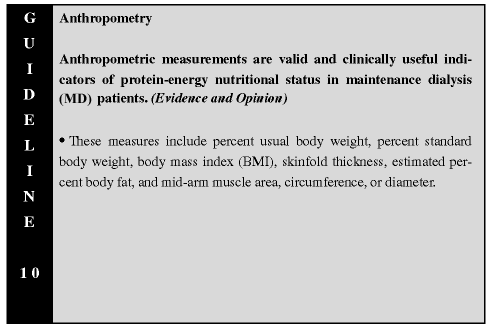
1. Evaluation of Protein-Energy Nutritional Status

Anthropometry quantifies body mass, provides a semiquantitative estimate of the components of body mass, particularly the bone, muscle, and fat compartments, and gives information concerning nutritional status.31,80-83 The anthropometric parameters that are generally assessed include body weight, height, skeletal frame size, skinfold thickness (an indicator of body fat), mid-arm muscle circumference (MAMC; an indicator of muscle mass), area, or diameter, or percent of the body mass that is fat, percent of usual body weight (%UBW), percent of standard (NHANES II) body weight (%SBW), and BMI. The various anthropometric measures provide different information concerning body composition; therefore, there are advantages to measuring all of the parameters indicated above. Hence, the emphasis given to different anthropometric parameters and their relative precision should be taken into consideration. Anthropometry requires precise techniques of measurement and the use of proper equipment to give accurate, reproducible data; otherwise, the measurements may give quite variable results.82 Some measures of anthropometry are more precise, such as %UBW, %SBW, and BMI, than are skinfold thickness and MAMC. Methods for performing anthropometry and calculating body composition from these measurements and reference tables are presented in Appendix VII.
In adult MD patients, height is not a valid method for measuring protein or energy nutritional status. However, it must be measured because it is used in height-adjusted reference tables for weight (including SBW and BMI). Because height may decrease with aging, particularly in MD patients who have bone disease, height should be measured annually. Skeletal frame size must also be determined to calculate an individual's %SBW (see Appendix VII).
Muscle area, diameter, or circumference is used to estimate muscle mass and, by inference, the fat-free mass and somatic protein pool. Significant changes in these measurements reflect changes in body muscle and somatic protein mass and may indicate a nutritionally compromised state. Anthropometry has been used to assess nutritional status in MHD and CPD patients.29,31,32,71,75,84 These studies indicate that muscle mass is decreased, often markedly, in many, if not the majority, of MD patients.
Anthropometric monitoring of the same patient longitudinally may provide valuable information concerning changes in nutritional status for that individual. The desirable or optimal anthropometric measures for MD patients have not been defined. There is evidence that MHD patients who have larger body-weight-for-height (eg, BMI) measurements are more likely to survive, at least for the subsequent 12 months.15,50,85,86 Patients in the lower 50th percentile of weight-for-height clearly have a reduced survival rate.15,85-87 One study indicates that MHD patients who are in the upper 10th percentile of body weight-for-height have the greatest 12-month survival rate.85
In contrast to these findings, virtually all studies of normal populations indicate that low weight-for-height measures are associated with greater survival, especially if the analyses are adjusted for the incidence of cigarette smoking in individuals with low BMI.88 Interpretation of these disparate findings among individuals undergoing MD and the normal population is also confounded by the lack of interventional trials in which a change in anthropometric measurements is correlated with clinical outcome.
Anthropometric measurements in MD patients can be compared with normal values obtained from the NHANES II data89 or with values from normal individuals who have the greatest longevity.88,90-97 Anthropometric norms for patients treated with HD are published and generally are similar to the values available for the general population.98 Differences in anthropometric measurements among MD patients and normal individuals may indicate a nutritional disorder or other clinical abnormality (eg, edema or amputation). The use of currently available anthropometric norms obtained from MD patients is of questionable value since age-, sex-, and race- or ethnicity-specific reference data are not available for this population. Furthermore, it has not been shown that the norms for MHD patients are desirable or healthy values.